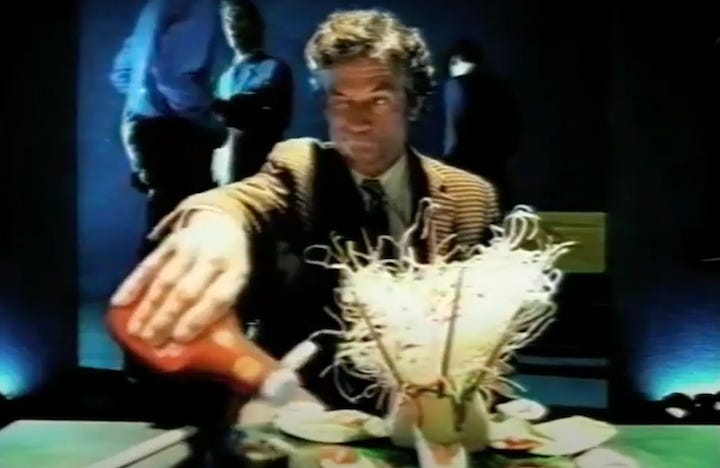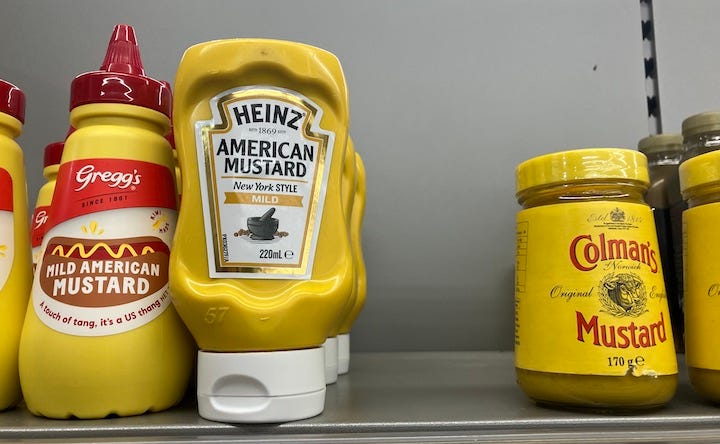The Ketchup Citizenship Test
You'll never be a Kiwi 'til you pick a tomato sauce

On our first trip to New Zealand, in 2019, we wound up at a New Year’s Eve bonfire in a holiday park tucked between farms outside the South Island town of Geraldine. The party was a cheerfully down-home affair. The fire, taller than I was, roared merrily in a misty summer rain. Parents drank BYO beers while kids ran laughing in and out of the firelight. Classic rock videos played on a bedsheet hung from a forklift. Off to one side was the sausage sizzle, that essential NZ ritual with the uncharacteristically flashy name. I queued up cautiously in the dark, and was soon handed a warm sausage wrapped in buttered white bread. Grilled onions? Sure. I turned to go, and our host called me back: “Did you get the sauce?”
The definite article—not some sauce, not any sauce—sparked hopes of discovering some unique and unmissable local condiment. In childhood road trips across my native U.S. Southwest I’d learned to map the thickness and heat of local salsas. What flavors would I meet on the Canterbury Plain? I accepted a squirt from an unmarked bottle. I took a bite. The Sauce was familiar. The Sauce was ketchup.
Or rather it was tomato sauce, as they call it here, and very much tomahto. Ketchup—the word and concept, if not its current recipe—comes originally from China1, but here in NZ the condiment has split into two nearly identical descendants. Ketchup generally has more tomatoes; tomato sauce has more sugar.2 The difference is minute but real: NZ’s preferred topping is thinner, sweeter, and fire-engine bright, while while America’s runs richer, tarter, and a shade closer to dried blood. “You can write that there are Kiwis that prefer Heinz ketchup (it’s absolutely better),” a friend here assures me. Truth, mate. Truth.
In Geraldine, though, The Sauce was tomato sauce. I’d bet my life on it. In America ketchup has a vibe of down-market universality; put it on fries, sure, but we’ve eaten more salsa for decades now. In NZ, though, tomato sauce is top-shelf Kiwiana. Our kids have grown up reading I Love Tomato Sauce!, an adorable picture book that uses one Lower Hutt family’s obsession with the condiment to introduce New Zealand Sign Langauge, one of the nation’s official languages. New Year’s Eve, parked at the peak of NZ’s short but gorgeous summer, can feel to an American something like July 4th; to serve anything but tomato sauce at a sausage sizzle seems faintly treasonous. I wiped my hands on my jeans and wandered back to the fire, where I met a young farmer in a ragged Speight’s hoodie who told me he’d never once been off the South Island. Score the whole night 100% Pure New Zealand.
Wattie’s, as it turns out, has long been invested in precisely this nationalistic agenda. Most famous is the brand’s vaguely threatening taunt “You’ll Never Be a Kiwi Till You Love Our Wattie’s Sauce”, sung as the chorus to a laundry list of Kiwi pastimes—cricket, haka, beer—that are still not Kiwi enough. The jingle later gets a gentler update (“You’ll Always Be a Kiwi if You Love Our Wattie's Sauce"), though now a white NZ bloke whips a bottle out of his plaid sportcoat to mark an otherwise too-foreign plate of sushi. More recently Wattie’s has billed itself as The Sauce of Kiwiness, with an outline of the islands drawn in ketchup. Compare all this to Heinz, an iconic American brand that rarely waves the flag. For years, in fact, their tagline was explicitly global: “THE LARGEST SELLING KETCHUP IN THE WORLD”.
The punchline you can spot a mile away: Heinz bought Wattie’s—not just the tomato sauce, but its whole veggie-canning empire—way back in 1992. The move had little to do with NZ’s tiny local market; Heinz explicitly billed the purchase as a bank shot to the Asian market. Globalization followed: Heinz moved production of Wattie’s Tomato Sauce to Australia from 2000 to 2012, and even after its return its Hastings factory uses tomato paste from California and Portugal. The “Never” ad I’ve seen dated as 1999, the “Always” as 2004, the “Kiwiness” maybe a decade after that; at least two and maybe all three are singing the Kiwi bonafides of a U.S.-owned business processing Californian and Portuguese tomatoes in Australia. (Meanwhile, KraftHeinz has since bought still another NZ tomato sauce brand, Gregg’s, but was forced to sell off their sauce recipe to avoid a monopoly.)
Who cares? We like to think we’ve become numb to such ironies. But Michael Beverland, a professor of marketing at the University of Sussex and a native New Zealander, argues that the striking nationalism of Wattie’s and other Kiwi brands is a uniquely New Zealand case. A little history here: even by American standards, NZ is a freakishly young country. Wattie’s was founded in Hawke’s Bay in 1934, only a year after New Zealand minted its own non-British coins. A distinct NZ citizenship didn’t exist until 1948; NZ passports declared their holders to be “British subjects” until 1973. Generations of NZ schoolchildren learned only British history; NZ history, while commonly taught in recent decades, did not become not a nationally required curriculum until 2022. Beverland argues this thinness of national identity was felt particularly acutely after World War II, when the NZ economy stalled as a battered UK turned to Europe. While the 1960s saw Māori New Zealanders kick off a political and cultural renaissance that continues to this day, Beverland argues that white New Zealanders “struggled for a collective sense of self.” Even a name for the group has been tricky. The Māori word Pākehā is now commonly used if not universally accepted; the government tried it out on the census awhile before settling on the weird geography of ‘NZ European.’ “It was this vacuum,” Beverland writes, “that brands helped fill.”
We Americans are no stranger to patriotic TV commercials, but ours tend broader and blurrier in their prescriptions. Chevy’s 1980s Heartbeat of America campaign was an impressionistic portrait of quirky national energy, the Budweiser Clydesdales have been a reliable source of dad-humor and tearjerkers for decades, and Clint Eastwood’s 2012 Halftime in America spot for Chrysler kept its resilience as vague as possible. Compare this to, say, Marmite ruling that Kiwi gals watch rugby instead of soaps, Speight’s deciding that a Kiwi bloke “uses his left hand to drink with” and “never sits down in public bars,” and a Wattie’s spokesman cheering on a kid who dips his broccoli in ketchup: “put on your Kiwi coat.”
My family’s fledgling Pākehā life, then, begins at the supermarket. When I buy ketchup, it’s for my five-year-old daughter, who does indeed put it on her veggies. My eight-year-old son can’t stand the stuff—he spent the first years of his life in China, where they’ve long since moved on. Jenny prefers mayo for her fries and I like yellow mustard, not least because here it’s labeled ‘American.’ But my daughter can’t remember living anywhere else. She’s the true New Zealander among us, the only one with those crater-lake Kiwi vowels. Very well: we would test her loyalties via The Sauce.
I bought a bottle of Heinz to pit it against the Wattie’s we already had at home. The familiar label was scuffed from its long journey. Where ya from? I wondered. “Made in the Netherlands,” the label said, which, OK, fine—Americans are used to that twinge of jealousy we get when our biggest brands run off with new friends.3 At home I squirted the Heinz and Watties into matching bowls marked Number 1 and Number 2, hid the bottles, and unwrapped the nuggets and chips.
“They taste the same to me,” she said. After a few more bites she allowed the Heinz was “goopier,” which neatly matched decades of Heinz ads extolling its slow pour. When pressed, she admitted a preference for Heinz: “It’s sweeter.” But Wattie’s has more sugar? Turns out our home control bottle was actually Wattie’s Lite, with only 18.1g of sugar per 100g. I’d unwittingly rigged the match in my favor. Of course I’d never buy Heinz 50% Less Added Sugar & Salt, because the name’s a dang paragraph and they just juice it up with stevia instead. Wattie’s Lite, though, I buy out of pure parental spite. It’s just Wattie’s. Cut the kids’ sugar anywhere you can. I don’t care and she’ll never know.
And my daughter didn’t care, either, until dinner was over and she spied the bottles on the counter.
“Is the Wattie’s the one that we’ve already done half of it?” she asked.
Yes, it was.
“I like Wattie’s better.”
She held the bottle and smiled down at the familiar label in her hands.
“Wattie’s,” she said again. Cooed, even, her voice bright with possession and even love.
I didn’t make midnight that New Year’s Eve in Geraldine. The farmer drifted off, I watched that Whitesnake video on the sheet overhead, then I headed back to take my shift with the sleeping babies. A year later we moved here in the pandemic—that’s another letter. My son’s now known as the American at school; on video calls the grandparents lean in and squint as they parse my daughter’s accent. I don’t know where in the world my kids will end up. But I hope they wander far enough someday to find themselves in lost the wrong season, amid strangers and fire, only to be brought up short by the taste of a childhood memory in the dark. No logos, no flags, only the heart saying: this could be mine.
And five years after Geraldine I’m typing this in our small North Island town as the kids are off at school. I’ve got my own Speight’s hoodie now. It keeps me warm as the May mornings turn frosty. I’m shy about wearing it out of the house, though. Once I sported it down at the local pub, ready to claim some low-hanging Kiwi cred. “Wrong beer,” the barman said. “That’s the South Island, mate.”
Kê-chiap, in the original Hokkien. An etymological mystery here. Southern Chinese immigrants came to both countries in the 19th century, so why did America take the loanword while NZ its English description? Was it simply a greater number of Chinese immigrants in the US during the condiment’s rise to fame? Or dogged English parochialism of early NZ? Or the same strain of Kiwi literalism that prefers the study ice block to the fanciful US popiscle?
From the labels, per hundred grams of sauce: Wattie’s Tomato Sauce uses 123g of tomatoes and 29.4g sugar, while Wattie’s Ketchup (they make both!) has 138g of tomatoes and 23.1g sugar. Heinz Ketchup has 167g of tomatoes and 25.8g of sugar.





Two thoughts:
1. Even if we knew of any Chinese origin, New Zealand was probably to racist to adopt a Chinese name for a product - we were pretty bad to them for nigh on a century.
2. It's possible the backstory is located in Europe rather than the USA, which had limited influence in NZ when it was starting to develop as a nation. We had imported brands of tomato sauce from England from the beginning, and one of the first commercial producers in NZ was called the Tomato Sauce Factory. People making their own sauces using home grown tomatoes might quite logically call the sauce they made from it tomato sauce. Delmaines, who make products superior to Watties, makes both Ketchup and Tomato Sauce, and claims a European origin (it was founded by an Italian).
Oops. Should'a worn some Tui merch, mate!